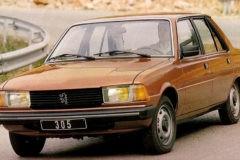The Peugeot 305 was from March 1979 not the expected real successor to the Peugeot 404. It was not a really big Peugeot in terms of size. The car was seen as a somewhat larger Peugeot 304. For doubters, there was therefore a choice between the most luxurious 304 or the (cheapest version of the) 504.
Making a choice was difficult
For people with a nostalgic penchant for the size of the 404, the top model of the Peugeot 305 seemed the better option. And that top model was, for example, in 1979, the Peugeot 305 SR. The SR engine was basically the same as the 1290's 304 cc engine, but with a larger stroke. With a stroke of 77 mm, the newcomer was just 'over square'. According to Peugeot, the one and a half liter four-cylinder produced 74 hp. On the (German) rollers, it turned out that 54 came from the front wheels. The block - still equipped with a manual choke - was therefore a good, somewhat pleasant, good pulling power source that helped the just under a tonne Peugeot to a pleasant performance.
He was fast enough
With a measured top speed of 150+ km / h, the car was fast enough with it. With its performance, the Peugeot 305 SR was able to hold its own in its segment. But for example the now almost forgotten Simca 1308 GT - Who has seen one in recent decades? - was just a rapper. At a time when cars in this segment are very economical with fuel, it seems a bit wild, but the average consumption of 1 in 10 was seen as very acceptable in 1979. At 140 km / h, the Peugeot consumed 1 in 9.
An 'all in one' construction
The gearbox and the differential turned in this engine's oil supply. That was once a novelty, the reliability of which was seriously questioned, but the design had more than proved itself in 1979. Moreover, the gear shifted pleasantly. In terms of chassis had the SR discs at the front, drums at the rear and a load-dependent limiter on the rear brakes. The power steering worked nicely without making the steering behavior feel 'dead'. The handling was good, the comfort too. The seats lacked the legendary French softness. And that was a plus.
The suspension and damping, on the other hand, were classically French soft. That was also a plus. The dashboard was well-arranged and red at night, a safety aspect that was once discovered when making instrument panels for fighter aircraft from the second world war. The rev counter was rather small and the fact that the windshield wiper / light switch and the ignition switch were positioned left, that was something that especially Peugeot owners could appreciate.
Larger than an 304
All in all, such a Peugeot 305 with its few centimeters larger wheelbase than the Peugeot 305 was seen as a good, nicely lined car without many sporting aspirations. The Peugeot was clearly a family car or company transport for ambitious field sales representatives with a sense of elegance.
The interior was comfortable, the luggage compartment impressive. And the fact that a very nice Peugeot 305 is now an affordable, valued classic? Well, on the other hand, these Peugeots in France can still be bought as 'old cars' for a handful of euros, and are used as daily free-range animals. And that must be proof that they are good.










In the 80s I tinkered with those things (professionally) and there was usually little wrong with the technical ...
Set contact points with the engine running and a key from the outside… ..
Nostalgia for this lady ...
I think you're a little limp about the fact that the 305 would be the replacement for the 404.
The 404 was already out of the program in 1974.
The 305 was certainly going to follow the 304, hence the 304 model from 1978 already got the front suspension of the 305.
I was working at Peugeot at the time and the last 305 that was still there would be my new car at the beginning of 1978, but I dropped it by passing my driver's license, it was an 304 SLS.
So that the 305 would be the replacement for the 404 is perhaps a tiny bit true, but it was the replacement for the 304.
With the "last" 305 I mean the last 304.
Completely agree, Jan Alting! The 504 is the successor to the 404 and the 305 the successor to the 304. (Unfortunately) I briefly drove a 305 with automatic transmission and sliding roof as a 'lead car', itself the standard car. Fantastic!
I was then the proud owner of such a Peugeot 305 SR, with sliding roof, brown metallic, etc. All options. After six months, the cladding showed holes, which was completely replaced. The sliding roof still showed traces of the cutting. After a year the door around the right door mirror started to rust through, no guarantee! After this, never taken a Peugeot again. For me the romance is off.